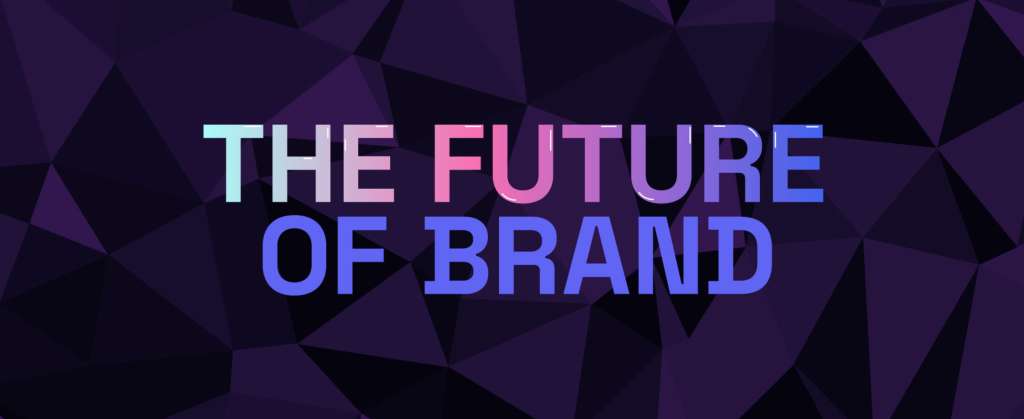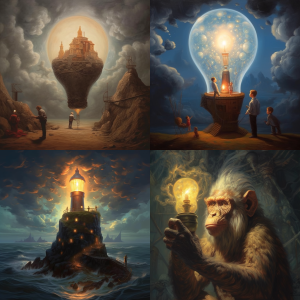
For our most recent Overit event, we had a fantastic time speculating on the future of brand. We brought together brand marketing experts from different disciplines and perspectives to share their thoughts and experiences.
- Jeremy Evans: Senior Graphic Designer, Overit
- Louis Wittig: Creative Director, Partners & Napier
- Jeanna Isham: Sonic Brander/Composer, Dreamr Productions, Sound in Marketing
- Ashleigh Lindsay: Founder, Digitally Grounded
- Doug Bartow: Director of Design, Overit
You can watch the full conversation on YouTube, or keep reading for a quick summary of takeaways!
Creative Director Louis Wittig started us off with an awesome primer that reviewed what a brand is and why it matters.
What is brand marketing and does it still matter?
Does brand marketing still matter? Brand marketing is a lot of work. It’s the big TV commercials you see. It’s the airplane that flies over the beach. It’s the big, broad messaging about brands.
Is this still worth it? Is this still something we should do now that we have what I would call algorithmic digital marketing? Basically, these ads follow you everywhere. We used to have big brand messages. Now we have these little ads that can follow us everywhere and they’re faster and more measurable than brand marketing.
And now we’ve got AI, which will soon let anyone with an iPhone mimic the distinct aesthetic qualities that make your brand stand out. Let’s say you’ve got a brand of potato chips and you’ve spent all this money on graphic design to make your beautiful logo and package. And now anyone can do that in 30 seconds. Is it still worth doing then?

What is a brand?
A brand is basically an argument about your product or service. It’s the bits of design, the bits of voice, and the bits of copywriting that make an almost subliminal argument about why you should use that product.
So, a brand is an argument… Aristotle knew something about arguments. What made a winning argument? He boiled it down to three things:
- Logos; which is basically Greek for, does this argument make sense?
- Then there’s Pathos. Does this argument make me feel something?
- And finally, Ethos, do I trust the person making this argument?
I’d say for a successful brand, Ethos equals trust. And trust is something that only human beings can have, right? You see lots of Facebook ads, but do you trust them?
Pathos is all about emotion. And only humans can do emotion. Only people can communicate emotions with one another. So perhaps AI can help with explaining something logically, but there are two-thirds of your arguments that only humans can do.
So how can brand marketing be more successful, more useful, and more relevant today in this very moment when it’s threatened by computers and AI? Well, I would say be more human.
Using AI as a tool
As the conversation shifted to the current uses of AI, Jeremy and Doug both explained how AI should be seen as a tool, not a replacement in the creative process.
Jeremy’s advice: “Embrace AI as a tool. It’s not going anywhere. But this also gives us an opportunity because these models are only being trained on things they’ve seen before. So there’s a lot of opportunity for us to create something that’s brand new, that’s never been seen before, that these algorithms wouldn’t even know about.” In a sea of images where everything looks beautiful and perfect, perhaps it’s the images full off human flaws that will stand out.
One practical use for AI image generation could be in the concepting phase when you’re showing an initial idea to a client for their approval. You could get the look and feel down without spending too much time creating something from scratch. Then once the idea is approved, the designer can move forward with their custom design.
Ashleigh explained that AI can be used as a better alternative to traditional stock photography because you’re able to customize it. Instead of sorting through hundreds of images, you can generate exactly what you need, including adding diversity that’s often lacking in stock photos.
On the written content side, you can certainly use tools like Chat-GPT to assist in your research process. Jeanna mentioned how she asked Chat-GPT to come up with five really great campaigns that Coca-Cola did to use in an article. “It referenced five different examples, and then I built it from there, and added my feelings and human-ness to it. So I’ve definitely used it to kind of give myself a prompt and idea and then flesh it out for myself.”
In conclusion, some ideas for using AI as a tool:
- In the concepting phase so you’re not spending too much time on an idea a client isn’t sold on.
- As an alternative to stock photography.
- To help expedite research time or help you spark ideas. (Especially if you’re having writer’s block.)
- Look at it as what not to do. Can you create an image that looks completely different than what is typical in AI?
The future of brand – humans and AI working together
So how do we as creative marketers find a balance in all this? We should use AI to make ourselves and our businesses more efficient, but without sacrificing our humanity. AI should be used on the back end to help us humans facilitate our own creativity. At the end of the day, going back to Aristotle, we need to build brands that people can have emotional connections with and that people can trust. And luckily for us, only humans can do that (at least for now).








